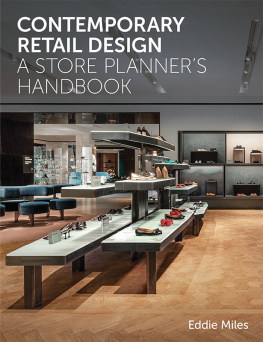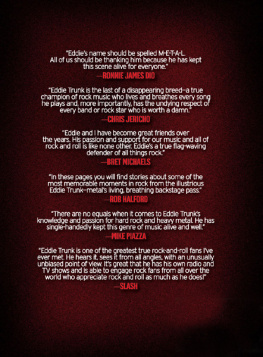Eddie Miles - Contemporary Retail Design
Here you can read online Eddie Miles - Contemporary Retail Design full text of the book (entire story) in english for free. Download pdf and epub, get meaning, cover and reviews about this ebook. publisher: The Crowood Press, genre: Romance novel. Description of the work, (preface) as well as reviews are available. Best literature library LitArk.com created for fans of good reading and offers a wide selection of genres:
Romance novel
Science fiction
Adventure
Detective
Science
History
Home and family
Prose
Art
Politics
Computer
Non-fiction
Religion
Business
Children
Humor
Choose a favorite category and find really read worthwhile books. Enjoy immersion in the world of imagination, feel the emotions of the characters or learn something new for yourself, make an fascinating discovery.
- Book:Contemporary Retail Design
- Author:
- Publisher:The Crowood Press
- Genre:
- Rating:5 / 5
- Favourites:Add to favourites
- Your mark:
- 100
- 1
- 2
- 3
- 4
- 5
Contemporary Retail Design: summary, description and annotation
We offer to read an annotation, description, summary or preface (depends on what the author of the book "Contemporary Retail Design" wrote himself). If you haven't found the necessary information about the book — write in the comments, we will try to find it.
Contemporary Retail Design — read online for free the complete book (whole text) full work
Below is the text of the book, divided by pages. System saving the place of the last page read, allows you to conveniently read the book "Contemporary Retail Design" online for free, without having to search again every time where you left off. Put a bookmark, and you can go to the page where you finished reading at any time.
Font size:
Interval:
Bookmark:

CONTEMPORARY
RETAIL DESIGN
A STORE PLANNERS
HANDBOOK

Lush Liverpool
Eddie Miles
CONTEMPORARY
RETAIL DESIGN
A STORE PLANNERS
HANDBOOK

First published in 2021 by
The Crowood Press Ltd
Ramsbury, Marlborough
Wiltshire SN8 2HR
www.crowood.com
This e-book first published in 2021
Eddie Miles 2021
All rights reserved. This e-book is copyright material and must not be copied, reproduced, transferred, distributed, leased, licensed or publicly performed or used in any way except as specifically permitted in writing by the publishers, as allowed under the terms and conditions under which it was purchased or as strictly permitted by applicable copyright law. Any unauthorised distribution or use of this text may be a direct infringement of the authors and publishers rights, and those responsible may be liable in law accordingly.
British Library Cataloguing-in-Publication Data
A catalogue record for this book is available from the British Library.
ISBN 978 1 78500 871 9
Front cover: Selfridges Womens Shoe Galleries, London. (Photo: Olivier Hess)
Cover design by Sergey Tsvetkov
Introduction
T HE DESIRE TO TRADE, TO MAKE THINGS or to provide services for others to purchase sets human beings apart from the other species of our planet. The methods by which these trading transactions are carried out are bewildering in their variety and continue to evolve to meet the needs of the consumer. Retail today, meaning here the retailing of goods and services to the end-user rather than business-to-business wholesale trade, is something we encounter pretty much every day. We fill our baskets online just as we browse the shopping mall stores, sometimes still out of a need but also for reasons of entertainment, to pass the time or to counter boredom. The design of the many retail environments we encounter is as familiar to us as our home or workplace but this doesnt lessen the challenge faced by the retail designer when planning a new store. The design of a successful store will have answered a multitude of questions in its conception: does the stores planning allow it to function seamlessly? Are the materials used in the construction robust? Is the interior space a delight to visit? Does the design encourage shoppers to stay and spend their money? The intention of this book is to explain store design and construction so that the designer, student of design or retailer gains a thorough understanding of what it takes to make a great retail space. As an architect, I can tell you that the one certain thing a retail client will state with absolute conviction in their brief is the store opening date! To this end, the book also explains the practicalities of project planning from concept to store opening.

The busy retail environment of Westfield World Trade Center, New York.
The effect of the coronavirus on the retail landscape of 2020 was of a scale unparalleled since the Second World War. For many retailers this was the final blow from which they could not recover, having already been affected by the rising costs of maintaining physical stores and the changing habits of customers. The retail world of today can therefore be a tough place, with shoppers habits changing rapidly and in unforeseen ways. There seems no doubt that online retail will continue to take an increasing share of our spend, but I remain optimistic for the physical store and its unique place in our towns and cities. Whilst the pandemic has undoubtedly driven custom online, it seems it has also created an opportunity for local retailers who have built a customer base from the many people who no longer spend their working week away from home. Rapid change creates opportunity and there will be innovators emerging with new ideas that will draw us back to the mall, high street and department store. I hope that this book will offer practical guidance to the designers of such future stores that will cry out to be visited and where we will take delight in shopping.
Chapter One
Store Types and Their History
ORIGIN OF THE STORE
Market Trading
The typical high street store can trace its lineage back to the markets of the Middle Ages. The market served as a meeting place to allow producers of goods, primarily foodstuffs, to barter or sell their products. Equally, the market was where imported goods were sold by merchants who had played no part in their actual production. As trading practices were codified and regulated, so the rights of towns to hold markets were controlled through charters which sought to control which goods could be sold and by whom. By the thirteenth century, the market square was established and remains a feature today in many European towns and cities. The relationship between market buyer and market seller seems to have been an unequal one. Without the systems of distribution we know today, the effects of scarcity and local shortages would have been acutely felt by buyers and much of the control over market trade was intended to protect the consumer from sharp practice. As well as the open-air marketplace, the stalls could be organized to trade from a market hall under the control of the municipality who oversaw trading practices, rules and regulations such as the control of weights and measures. As the markets developed, so did the traders temporary stalls which were designed to display and to protect merchandise. These stalls became semi-permanent and by the fourteenth century examples of permanent structures are found, some of two storeys with the owners living quarters on the floor above.

Eighteenth-century storefront with characteristic bow-fronted oriel windows in Londons Haymarket.
John Stows Survey of London , published in 1598, describes this development in his recollection of how Old Fish Street in the City of London had developed in his time:
these houses, now possessed by fishmongers, were at the first but moveable boards (or stalls), set out on market-days, to show their fish there to be sold; but procuring license to set up sheds, they grew to shops, and by little and little to tall houses, of three or four stories in height, and now are called Fish street.
By the early part of the seventeenth century, a new consumer society was emerging in London. By the mid 1600s, Londons population stood at over half a million, a five-fold increase over a hundred years. The growth in population also concentrated the wealthy in a single city which began to draw in products and consumer goods from the provinces and further afield. London thus became the focus of politics, culture and consumerism, populated and visited by gentry and nobility with the means to spend ostentatiously. Contemporary records, such as the diaries of Samuel Pepys and John Evelyn, give todays reader a fascinating insight into the retail world of the mid 1600s. Here, for instance, is John Evelyns account of his visit to Paris on 3 February 1664: Here is a shop called NOAHS ARK, where are sold all curiosities, natural or artificial, Indian or European, for luxury or use, as cabinets, shells, ivory, porcelain, dried fishes, insects, birds, pictures, and a thousand exotic extravagances.
Font size:
Interval:
Bookmark:
Similar books «Contemporary Retail Design»
Look at similar books to Contemporary Retail Design. We have selected literature similar in name and meaning in the hope of providing readers with more options to find new, interesting, not yet read works.
Discussion, reviews of the book Contemporary Retail Design and just readers' own opinions. Leave your comments, write what you think about the work, its meaning or the main characters. Specify what exactly you liked and what you didn't like, and why you think so.












